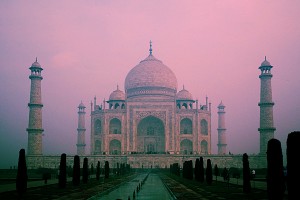Death, Love and the Taj Mahal
 The Taj Mahal is a tomb. A gigantic, elaborate headstone for a grief-stricken emperor’s favorite wife. Here’s the story.
The Taj Mahal is a tomb. A gigantic, elaborate headstone for a grief-stricken emperor’s favorite wife. Here’s the story.
In the early 16th century, the Muslim emperor Babur, through a series of military conquests, established the Mughal dynasty in India, which lasted all the way until the reign of the British. Babur was a direct descendant of Genghis Khan (through his mother) and of the conqueror Timur (a.k.a. Tamerlane, founder of the Timurid dynasty) through his father.
In 1592 Babur’s great-great-grandson Prince Khurram Shihab-ud-din Muhammad was born, and in 1607 at the tender age of 15 was betrothed to the 14-year old Agra-born daughter of a Persian noble. They would have to wait 5 years until their actual marriage, however, the court astrologers deeming this future date to be more conducive to a happy marriage.
So at a respective 20 and 19 years of age, they were married in 1612, she to become Prince Khurram’s third (and favorite) wife. Entirely besotted with her, Khurram renamed her Mumtaz Mahal (Jewel of the Palace), “finding her in appearance and character elect among all the women of the time.”
It was, by all accounts, a blissfully happy marriage. Mumtaz accompanied her husband everywhere, including his military campaigns, and was his trusted advisor and companion. Prince Khurrian became the fifth Mughal emperor (thereafter known as Shah Jahan) when he successfully fought for the throne in 1628, but unlike many emperor’s wives Mumtaz steered clear of court intrigues and politics. From all accounts, she was beloved of all.
Mumtaz would bear 13 children to Shah Jahan before dying during the birth of her 14th child in 1631. She was 38.
Shah Jahan’s grief at his wife’s death was immense, and immediately he ordered for work to begin on the mausoleum for her grave, the Taj Mahal, to be built in her birth city of Agra.
At a cost in today’s currency of billions of dollars, some 20,000 workers were recruited to work on the project from around the kingdom, from laborers to the most skilled artisans and specialists of the time.
White marble, jasper, jade, crystal, turquoise, lapiz, sapphire, carnelian and scores of other precious and semi-precious stones were imported from such far away places as China, Tibet, Afghanistan, Arabia, Europe and Sri Lanka.
Twelve years later, the tomb was complete, and the gardens, mosque and gateways another ten years after that.
Billed as the world’s greatest monument to love, the Taj sees 2 – 4 million visitors annually and is one of the New Seven Wonders of the World. Indian poet Rabindranath Tagore has described it as “a teardrop on the face of eternity,” while Rudyard Kipling called it “the embodiment of all things pure.”
In his own words, however, here is how Shah Jahan (who would eventually be interred right next to his beloved wife), describes the Taj Mahal:
Should guilty seek asylum here,
Like one pardoned, he becomes free from sin.
Should a sinner make his way to this mansion,
All his past sins are to be washed away.
The sight of this mansion creates sorrowing sighs;
And the sun and the moon shed tears from their eyes.
In this world this edifice has been made;
To display thereby the creator’s glory.
 Click to subscribe via RSS feed
Click to subscribe via RSS feed

Nice shot of the Taj Mahal! Was this early morning or late afternoon?
Thanks. ‘Twas in the morning.
What time does Taj Mahal open for visitors? I wouldn’t want hundreds of tourists around me when I try to appreciate Taj Mahal.
14 children in 18 years of marriage. Hmm… that sounds very exhausting to me!
No matter what time you visit the Taj Mahal, you will be surrounded not by hundreds, but by thousands of visitors. Two to four million visitors annually translates to a good 10,000 visitors per day.
Both times I was there Gabe was round 6 in the morning. And both times, there was hardly anyone there. Although beautiful, I found it t be quite depressing for some odd reason. Shouldn’t there be a classic photo with you on the white bench?
I refused to do the white bench photo. Princess Diana I am not. 😉
Oh come on! I’m sure you can think of something no Diana like. Maybe sitting in lotus or something.